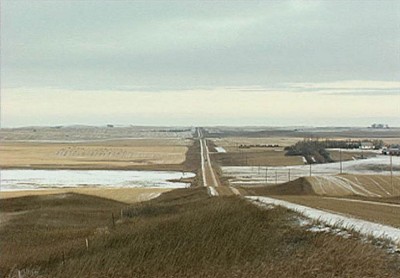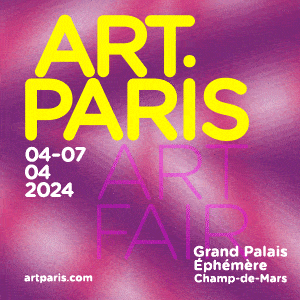Whitehot Magazine
April 2024
"The Best Art In The World"
"The Best Art In The World"
April 2024
April 07 WM Issue #2: Plains of Sweet Regret @ Lennon Weinburg Gallery

- SIGN ON EMPTY CABIN, TEXAS PANHANDLE, 1886
If the North Dakotans left such notes, such notes were blown off long ago, down the road that dips and rises all the way to the horizon line without meeting another human settlement. Blown, one imagines, by the same strong gust that curled the dead leaf around the gilt athletic trophy sprawled supine the driveway of the abandoned farmhouse. Such were the signs Mary Lucier found when she traveled the northwestern regions of the state. No words, no explanations, only the cast-off shells and toppled monuments of the fled.
Lucier's five channel video installation, "Plains of Sweet Regret," housed at the Lennon Weinburg Gallery on 25th street though April 28, is among several pieces commissioned by the North Dakota museum of art to respond to “The emptying out of the Plains,” a great population shift that has lead the small farmer out and agribusiness in. It is Lucier's second collaboration with a woman she calls "visionary;" museum director Laurel Reutor; following "Floodsongs," a piece she made to commemorative a catastrophic flood in North Dakota in 1997.
The catastrophe here in Plains of Sweet Regret is muted; is of the more diffuse, incipient kind. It is the tragedy of the gilt athletic trophy in the dust, cinched at the waist as it bends too far back, nearly double, so that heroism turns to masochism, striving atrophies. In the abandoned house a kettle sits rusting on the empty hearth; in the Rodeo ring a toppled rider swings his arm in a gesture of defeat; the utmost human endurance is met with a more relentless resistance from outside. "The combination of beauty and desperation interests me,” says Lucier.
The first sign of life in modern North Dakota is a blonde farmer’s wife. Her golden blow-dried hair, which matches the athletic trophy in hue and luster, speaks with the same solemnity of humanity insistently commemorating itself against a vast expanse of utterly indifferent land. The way Lucier records this carefully arranged hair could work as a snub were she a less reverent observer. In fact one of the work's most radiant quality is the marked absence in it of both distain for and idealization of rural life, both of which naive emotional responses all too often impoverish the glance cast from the metropolis towards the provinces.
"We are the centre and the circumference," said one of the North Dakotans who responded to a questionnaire Lucier distributed to residents asking “What do the plains mean to you?” The idea of being both center and circumference, Lucier says, belongs to the Zen tradition. It has accidental but potent prescience for the viewer who stands in Lennon Weinburg on 25th street and watches Plains; who finds that he, who moments ago considered himself to be standing in the economic and cultural center of the country and perhaps of the world, is filled with indescribable longing for a far off place; finds he is in fact standing at the circumference, gazing in not only at the source of his own grain, but at the source of his own most deeply felt myths. The lone farmer, the cowboy; the independent man, the freedom of the frontier.
Between its explorations of desolation and bravery the video dips into the prosaic; more specifically, into the backstage of a high school play where two young actors do preparatory head rolls. Lucier wished to suggest the possibility of sensuality here, and the use of the footage demonstrate her suppleness. She lets this moment rest, ambiguous and in relative isolation, precluding the possibility of collapsing the whole work into the vehicle for any one message.
The piece is nevertheless suffused with motifs, and preeminent among these is struggle. A calve writhes on the barnyard floor till the farmer leans over, tenderly, and pulls back the placenta wall. Yellow liquid rushes forth; a grotesque chorus of new life, then the startled eye as the calf rises, dubious at its own sudden appearance under the sun. Next we enter the rodeo ring. All six screens synch up and the focus, which has passed around balletically, following Lucier’s meticulous multiscreen editing, rests gravely on the ritual about to be enacted. The rider enters the ring. Bucked off instantly he clings tenaciously to the bull’s horn, which dips dangerously near his soft belly. Other men rush into the ring and try to contain the bull and are tossed off like so much rubbish. It is a total reversal of the previous power relation between farmer and calf. The interdependence is as total but the binding sinew is now death, not life.
Violence becomes beauty: we are in the presence of Duende-the term Lorca coined/appropriated to describe a transcendent quality that infuses certain performances (for him Matadors, flamenco guitarists and flamenco dancers, but the term might fairly be applied to the rodeo also), which Lorca himself could not verbalize but which he aligned closely with the struggle against death. The scene in the rodeo ring is played again, this time the image is superimposed over its own reverse, so that at some points the rider appears to be struggling against himself. He is. The rodeo, we see, is a ritual in which man battles himself through the medium of a bull.
As with any piece of art that combines strong formal aspects and richness of vision with a lack of didacticism, the rodeo scene yields itself to multitudinous readings, each dragging along with it filaments of visual text. I suggest one that may be termed miraculist, but ought not be called far-fetched.
When the dark sections of pigment overlap in the doubled over image, shapes appear which act as a sort of Rorschach on the viewer, rearranging to invoke, variously, a totem, a beast, a changeable god. Somewhere in the clashing of the Coors light jacket with itself in reverse, in the writhing body of the beast with two backs, in the flailing of hair, there appeared to me a visual texture strikingly similar to the aesthetic of the northern Plains Indians.
At this moment of unbidden reference the story, like the image, doubles over upon itself. For if Plains of Sweet Regret addresses the current emptying out of the plains of its European-descended inhabitants, does not this swift abandoning echo another disappearance? Namely, that which occurred in the not-so-distant past when the Dakotas were definitively emptied of their Native American inhabitants by white settlers?
Far from casting Lucier a sort of Victorian ghost photographer, insisting on this uncanny invocation only creates the comforting sense that the thing she has captured; struggle, dispossession, violence, courage, react upon a historical span longer than the one she dealt with explicitly.

Sofi Thanhauser
Sofi Thanhauser is a freelance writer in New York City.












